Etruscan Enigma Unveiled: Tarquinia and Tuscania - Journey into a Civilization Shrouded in Mystery

Buongiorno and welcome to Stefano’s RomeCabs, Rome’s top-rated tour company for Italy tours from Rome, and Civitavecchia Shore Excursions.
Tuscania and Tarquinia, two remarkable ancient Etruscan cities featured on our signature Mysterious Etruscans Countryside Tour, beckon travelers and cruisers on a captivating journey into the heart of a bygone civilization that continues to mystify and intrigue. Tucked away in the scenic landscapes of the Roman countryside, they hold the keys to unlocking the enigma of the Etruscans.
Tuscania and Tarquinia are important not just because they are repositories of invaluable archaeological treasures, but also because they offer a tangible connection to a civilization that predates the Roman Empire. A journey to these enchanting towns, coupled with the exploration of their sacred subterranean tombs, feels like stepping through a portal in time. It offers an immersive experience into a realm where the Etruscans flourished, unveiling their customs, artistic achievements, and profound spirituality.
By visiting Tuscania and Tarquinia on a day tour from Rome or a Shore Excursion from Civitavecchia, you embark on an extraordinary odyssey to understand the essence of a civilization shrouded in mystery, and in doing so, you contribute to the preservation of a rich and enigmatic heritage that continues to captivate the imagination of history enthusiasts and scholars worldwide.
Etruscan Enigma: Tarquinia & Tuscania -
Discover a Civilization Shrouded in Mystery
Before we journey to Tarquinia and Tuscania in the ancient land of the Etruscans once known as Etruria, let's first find out who were these mysterious Etruscans and why they played such a significant role in Italy's history and culture.
Who were the Etruscans and why were they important?
Before the emergence of the Roman Empire, the Etruscans reigned as the dominant culture on the Italian Peninsula. Flourishing between the 8th and 3rd centuries BCE, their civilization left an indelible mark that continues to intrigue scholars and history enthusiasts to this day.
The Etruscans' reign over the Italian Peninsula was not just a historical footnote but a transformative era that laid the foundation for much of Italy's subsequent cultural development. Their contributions, from intricate metalwork to urban planning, paved the way for the Roman Empire to emerge. Moreover, the Etruscans' mysterious language, still incompletely deciphered, adds an element of mystery to their story, making them an enduring subject of fascination for historians and archaeologists.
To understand the depth of their influence, it is imperative to delve deeper into the various facets of their civilization and uncover the intriguing enigma that continues to shape the nation's identity today.
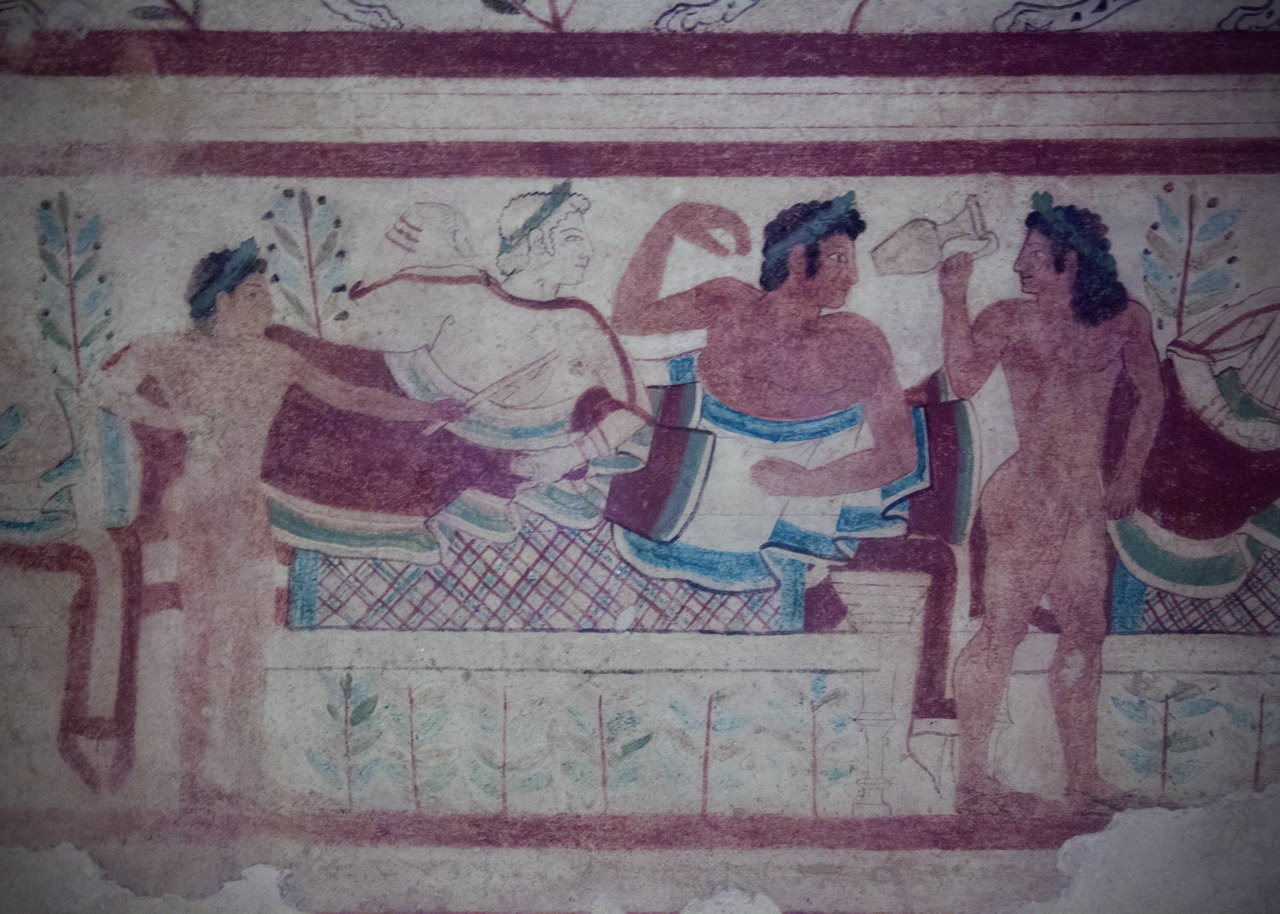
Etruscans’ Profound Influence
At the heart of the Etruscan influence was their geographical location. Situated in central Italy, they served as a crossroads for trade and cultural exchange between various Mediterranean civilizations. This proximity exposed them to a myriad of ideas, technologies, and artistic influences.
The Etruscans absorbed and amalgamated these influences, resulting in a distinctive culture that fused elements from the Greeks, Phoenicians, and indigenous Italian peoples. This fusion enriched their cultural landscape, allowing them to excel in a multitude of fields.
Etruscan art and engineering were truly remarkable. Their metalwork was renowned for its intricate designs and craftsmanship, setting a high standard for the ancient world. Etruscan bronze sculptures, such as the renowned "Chimera of Arezzo" exemplify their mastery of metallurgy.
Their pottery, characterized by intricate patterns and graceful forms, served not only utilitarian purposes but also showcased a keen aesthetic sensibility. This Etruscan pottery can be seen as a precursor to the exquisite Roman ceramics that would adorn the tables of the Roman elite in later centuries. Additionally, the Etruscan sarcophagi, notably exemplified by the iconic Sarcophagus of the Spouses, served as a wellspring of inspiration for the Romans, influencing their own artistic and funerary traditions.
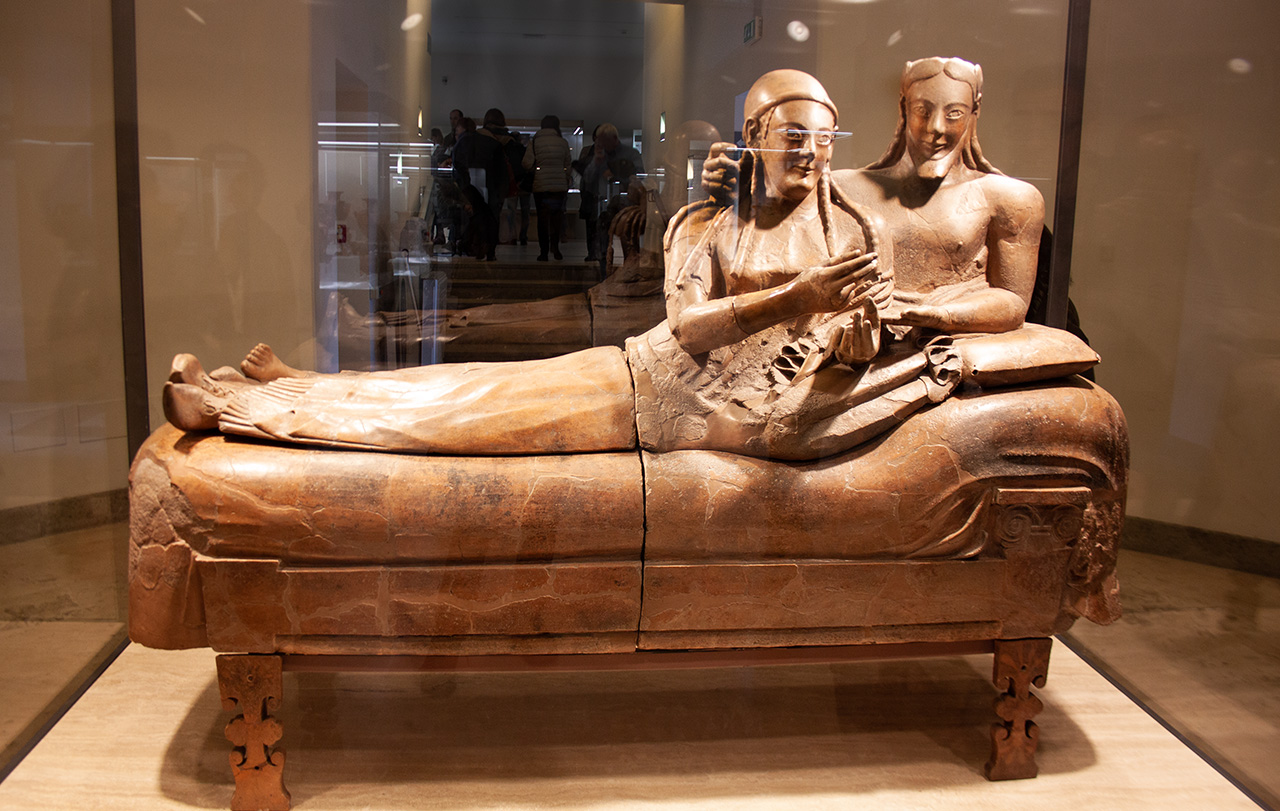
Etruscan Architectural Marvels
Etruscan architectural innovation is evident in the construction of cities like Tarquinia and Tuscania. They engineered complex drainage systems and built grand temples and elaborate tombs. Their architectural legacy laid the groundwork for Rome's grandeur, shaping the city in ways we still admire today.
The Etruscans pioneered the arch, revolutionizing construction and enabling the creation of stable and monumental structures such as aqueducts and bridges. Their mastery of vaulted ceilings, including barrel and cross vaults, became the foundation of Rome's awe-inspiring vaulted architecture.
Etruscan city planning, characterized by grid-based layouts and advanced drainage systems, influenced the organization of Rome's streets and infrastructure. Their temple design, featuring raised podiums and front-facing columns, left an indelible mark on Roman religious architecture.
Even the sophisticated sewage systems of the Etruscans found their way into Roman city planning, ensuring efficient waste management. The 6th century BC sewer system in the Roman Forum, known as the Cloaca Maxima, is one of the most well-known examples of ancient Roman engineering, and it has its roots in Etruscan contributions.
Etruscan engineering also paved the way for Rome's intricate aqueducts, delivering water to the heart of the empire.
The legacy of Etruscan civic buildings, exemplified by the capitolium, became blueprints for Roman equivalents, shaping the civic landscape. Lastly, Etruscan fortifications fortified Roman military and city defenses, safeguarding the empire's security.
This fusion of Etruscan and Roman architectural ingenuity created the bedrock of Western architecture and engineering, forming an enduring legacy that continues to inspire and captivate us today.
Uniqueness of the Etruscan Language
One of the most intriguing aspects of Etruscan culture is their language. Despite their significant influence, the Etruscan language remains largely undeciphered, with only fragments and inscriptions to offer tantalizing hints of its complexity. This linguistic mystery continues to perplex scholars, leaving us with a profound sense of the unknown in the Etruscan legacy.

Etruscan Spirituality and Afterlife
Spirituality played a pivotal role in Etruscan life. Their religious beliefs were deeply intertwined with nature and the cosmos. They believed in divination, reading signs in the flight of birds and the entrails of sacrificial animals. These beliefs would leave a lasting mark on Roman religious practices, as the Romans borrowed heavily from Etruscan rituals.
For the Etruscans, life transcended death. Funeral art sets Tarquinia apart from all other necropolises for its remarkable frescoed tombs. As you step into these subterranean chambers, you are transported back in time to this bygone civilization. The frescoes that adorn the tomb walls are the key to understanding their beliefs and rituals.
TARQUINIA - A Portal into Etruscan Life
As we delve deeper into the enigmatic world of the Etruscans, our journey leads us to Tarquinia, a pivotal city in the Etruscan civilization that thrived from the 9th to the 2nd Century BC.
Tarquinia, known in ancient times as Tarquinii, ascended to become a powerful and influential Etruscan city due to a combination of strategic factors, geographical advantages, and cultural developments.
Over time, Tarquinia's prosperity and influence expanded, and it played a vital role within the Etruscan League, a confederation of Etruscan city-states that engaged in alliances and trade agreements. This league allowed Tarquinia to strengthen its position in the region and participate in a broader network of economic and political relationships.
Tarquinia’s geographical advantage
Tarquinia's location in central Italy, along the western coast of the Italian Peninsula, provided it with strategic advantages. Positioned on a plateau overlooking the Tyrrhenian Sea, Tarquinia had easy access to both the sea and inland routes. The city's elevated position on a plateau offered natural defenses against potential invaders. It was easier to defend against external threats, which contributed to Tarquinia's security and stability.
Tarquinia's strategic location and access to the sea facilitated trade with neighboring regions, including the Greek colonies in southern Italy and the Phoenician settlements in the western Mediterranean. This trade brought wealth and cultural influences to the city. The fertile plains surrounding Tarquinia were conducive to agriculture, enabling the city to sustain a growing population. The production of food and other resources further fueled its development.
The city's combination of natural advantages, cultural achievements, and strategic positioning allowed it to thrive and exert its influence on the broader Etruscan civilization, making Tarquinia a powerful and significant center of Etruscan culture and politics.
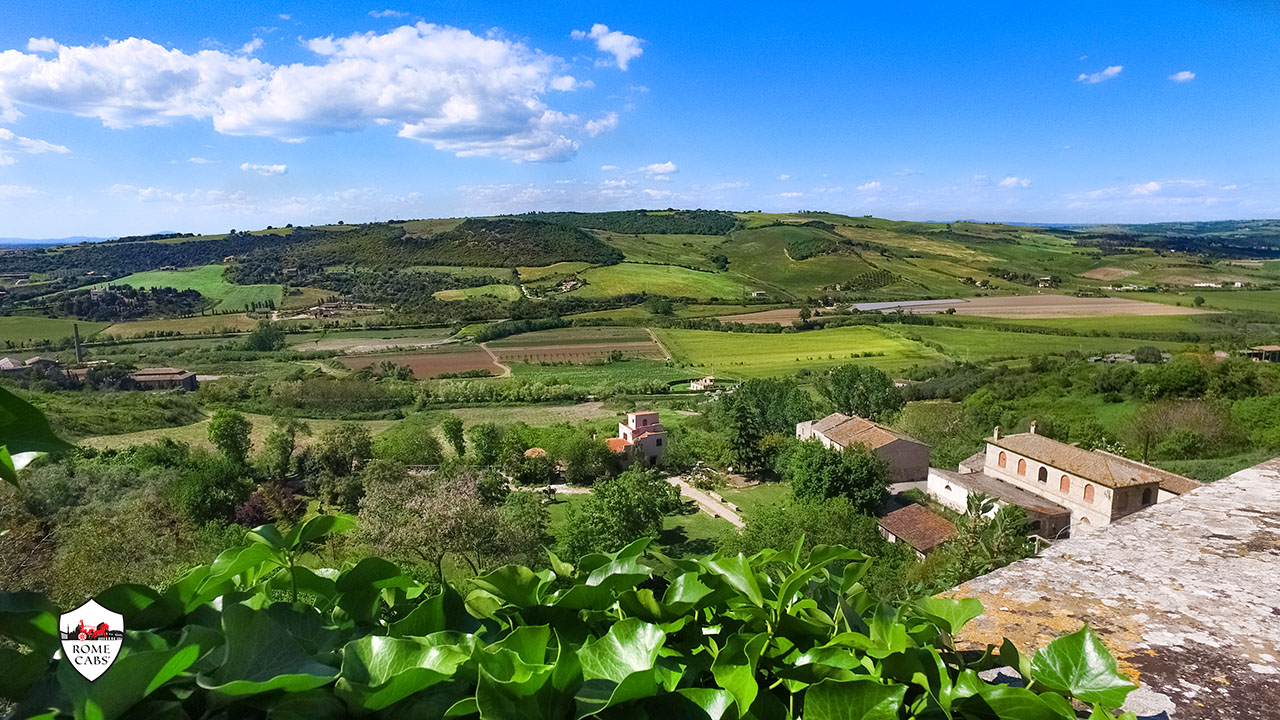
The "Tarquins" - Etruscan Aristocratic Class and Legendary Kings of Rome
Tarquinia, like other Etruscan cities, had a distinct political structure characterized by an aristocratic ruling class. Tarquinia was ruled by influential Etruscan noble families, such as the Tarquinii and the Velianas, who held power and authority in the city for extended periods.
The Tarquinian Dynasty included influential rulers like Tarquinius Priscus and Tarquinius Superbus who ruled over Rome as Kings during its early history as a monarchy and played significant roles in shaping early Roman history and architecture. Their rule is a notable chapter in the transition from Rome's monarchy to its republican form of government.
Lucius Tarquinius Priscus (Tarquin the Elder) was the fifth legendary king of Rome, reigning from 616 BC to 579 BC. Servius Tullius was the sixth legendary king of Rome, ruling from 578 BC to 535 BC. He is said to have been the son-in-law of Tarquinius Priscus. Lucius Tarquinius Superbus (Tarquin the Proud) was the seventh and final legendary king of Rome, reigning from 535 BC to 509 BC. His rule was marked by increasing tyranny and cruelty, which ultimately led to his downfall.
These dynastic leaders played a crucial role in shaping the city's destiny and allowed for effective governance and the ability to make decisions that furthered the city's interests.
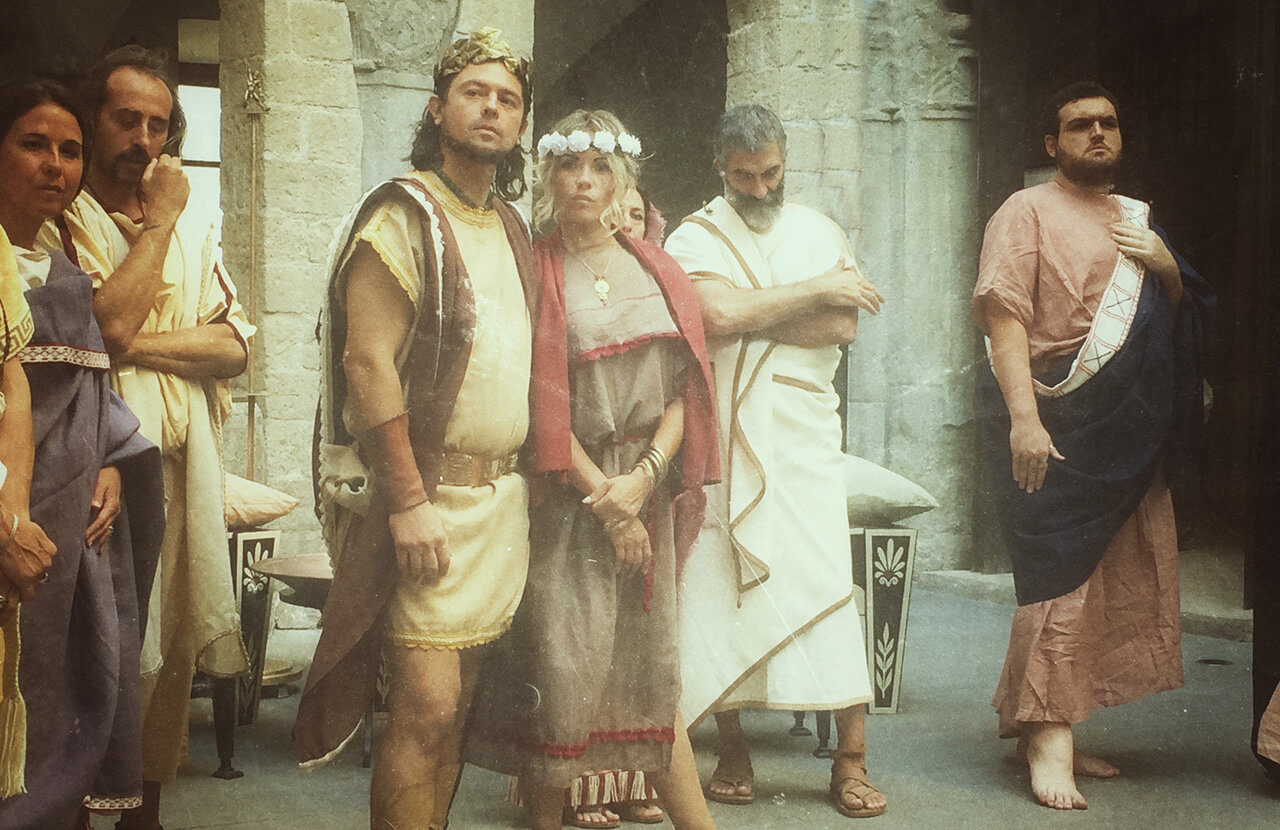
Tarquinia's Painted Tombs: Bringing Etruscans to Life
The frescoes that adorn the walls of the underground tombs of Monterozzi Etruscan Necropolis outside the city boundary are artistic repositories of Etruscan rituals, symbolism, and legacy. They were not only symbolic but also practical. They served as a way to preserve the memory of the deceased, ensuring that their stories and legacies endured through the ages. The art on the walls celebrated the achievements and experiences of the individuals interred within.
Venture into the burial chambers, and you'll find yourself transported to domestic settings adorned with frescoes that narrate religious and mystical dramas. The frescoes found in the Tarquinia tombs are nothing short of astonishing. Scenes unfold before your eyes—funeral feasts, spirited dancers, athletes, and musicians serenading with the aulòs.
These visual compositions served a dual purpose: to help the departed remember their earthly existence and to console grieving loved ones. Yet, the narrative evolves, echoing the fate of the Etruscan civilization.
The Tomb of the Jugglers features scenes of jugglers and acrobats, conveying a sense of entertainment and festivity. Also not to be missed is the Tomb of the Lioness which features a great crater flanked by two musicians and dancers, evoking an atmosphere of entertainment and festivity. The walls on either side are adorned with depictions of reclining banqueting diners, creating a vivid tableau of celebration and merriment.

At the zenith of the Etruscan civilization during the 5th century BC, their tombs resonated with an exuberant and celebratory ambiance, embodying the vitality of an era steeped in cultural richness. This is brilliantly depicted within tombs such as the Tomb of the Leopards, a captivating testament to the Etruscans' profound appreciation for life's exuberance, where art and revelry unite in an enduring celebration of existence.
On the back wall, an exuberant banquet scene unfolds beckoning you to join the three joyous couples reclining on sumptuous klinai (couches). In a harmonious tableau, servants gracefully bear vessels of libations to the delighted guests, enhancing the festive ambiance.
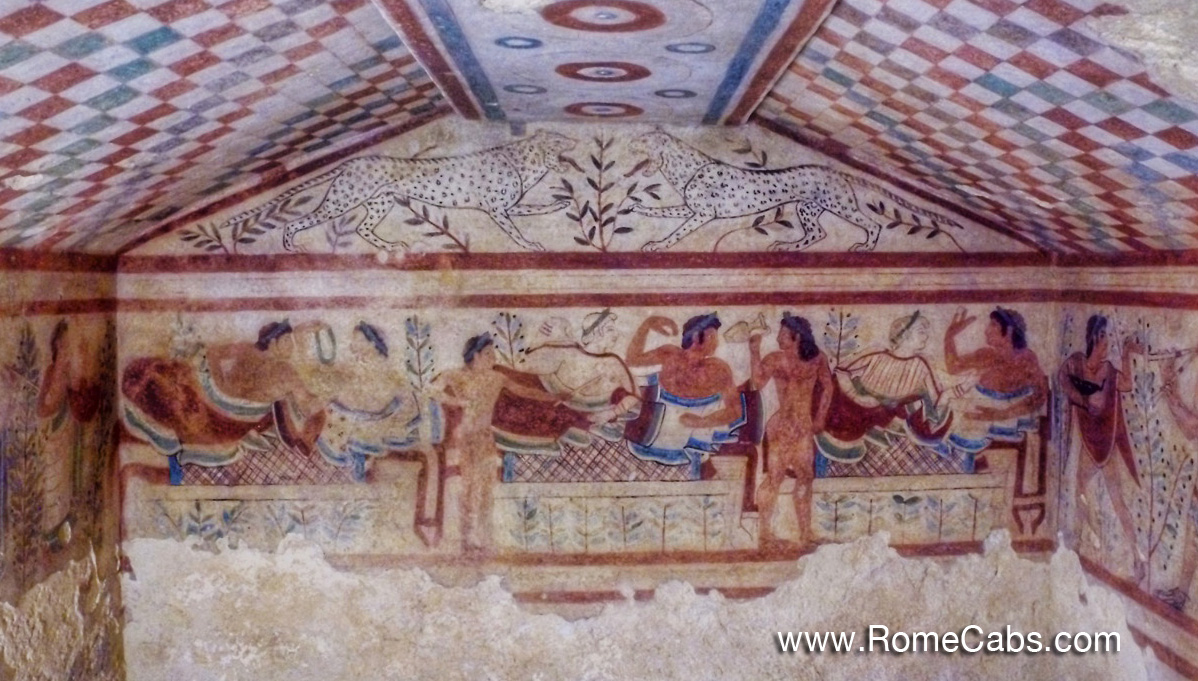
However, with the advent of the 3rd century BC, a period fraught with the gradual subjugation of their independent city-states beneath the looming dominance of Rome, a profound transformation unfurled. Eerie and diabolical scenes, etched upon the tomb walls, unfolded like an ominous harbinger, casting a somber and foreboding shadow over these once-vibrant burial chambers. These macabre frescoes seemed to echo the uncertain destiny that loomed over the Etruscan civilization itself, as it stood on the precipice of an inexorable transformation.
This transformation is notably evident in the Anina Tomb, dating back to the 3rd century BC and named after the prominent Anina family of Tarquinia. Here, on either side of the tomb's entrance, two haunting Etruscan mythological figures associated with the afterlife and underworld: Charun, with an otherworldly cerulean skin, stands as a guardian wielding a menacing hammer, and Vanth, an equally spectral and ethereal figure, clutches a torch that guides departed souls on their journey into the afterlife.
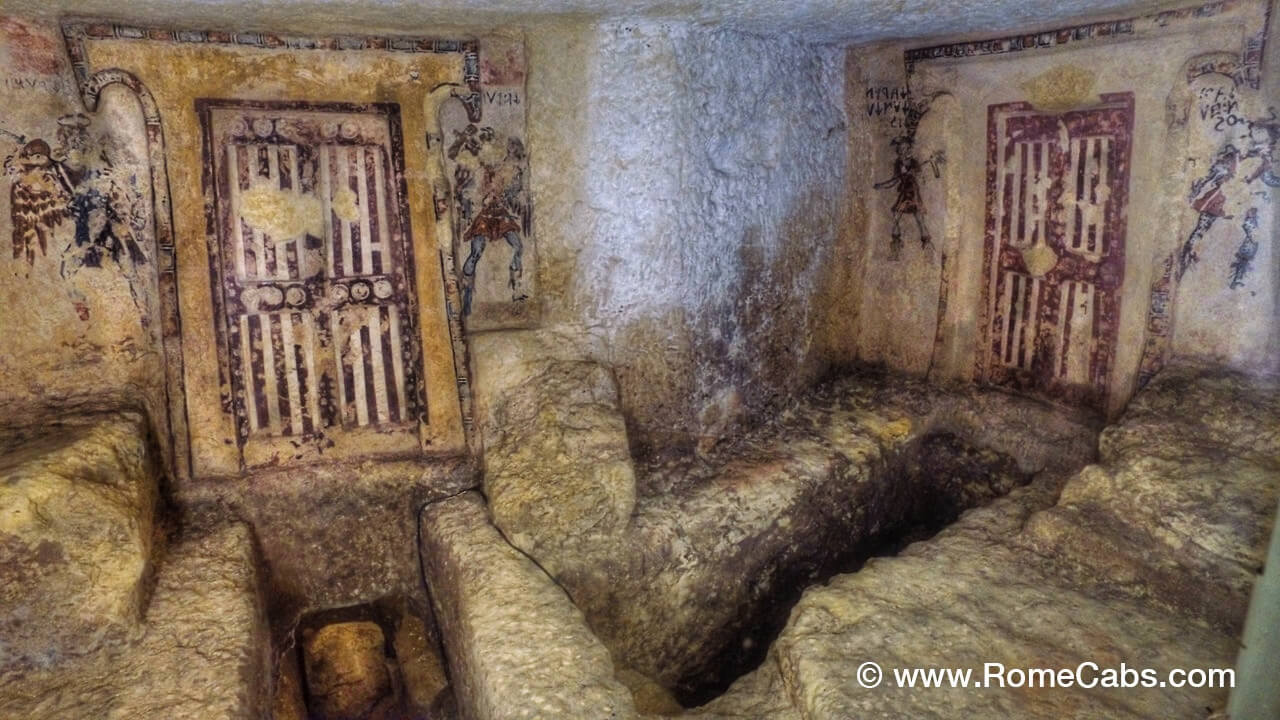
Within the Tomb of the Two Roofs, dating back to the 2nd century BC, a central pillar commands attention, adorned with an imposing figure of Charun. Along the side walls, pseudo-sarcophagi stand adorned with inscriptions, offering cryptic messages from a bygone era. Notably, the right wall hosts a miniature frieze that intricately captures the poignant odyssey of the departed as they embark on their journey to the realm of Hades.
Etruscan burial practices included placing grave goods, such as jewelry, pottery, sarcophagi, armor, and personal items, alongside the deceased in their tombs. These items were meant to accompany the individual into the afterlife, reflecting a belief in a continuation of life beyond death. Over time, many of these grave goods were looted, deteriorated, or discovered and housed in museums such as the National Museum of Tarquinia.
While the Etruscan language itself remains largely undeciphered, the frescoes speak a universal language. They convey emotions, stories, and a sense of community that transcends linguistic barriers. Through these vibrant and meticulously crafted paintings, we gain a profound understanding of the Etruscan way of life.
The mysteries concealed within the tombs of Tarquinia continue to captivate archaeologists and historians. Each fresco holds the potential to unveil a new piece of the Etruscan puzzle. The enduring fascination with these artworks reflects the deep connection between art, spirituality, and identity in the ancient world.
As you explore Tarquinia's necropolis, you embark on a journey through time, unraveling the mysteries of a civilization that has left an indelible mark on Italy's cultural tapestry.
What happened to Tarquinia after the Etruscans?
After the Roman conquest of Tarquinia in 280 BC, the city underwent a transformation. It continued to thrive as a Roman municipality, benefiting from its strategic location and economic activities, particularly trade.
During the Middle Ages, as the Western Roman Empire faced instability and decline, Tarquinia experienced periods of invasions and political changes, including Ostrogothic and Byzantine rule. Tarquinia's character transformed with each passing century, ultimately embracing its medieval identity as it grew into a medieval stronghold with formidable defensive walls, soaring towers, and Christian religious sites.
Tarquinia's medieval heart beats on, where echoes of its Etruscan heritage harmonize with Italy's evolving history.
Tuscania: A Hidden Gem of Ancient Etruria
A short drive from Tarquinia takes you to Tuscania, a quaint town that has preserved the legacy of the Etruscans in its own unique way.
Tuscania's Etruscan Origins
Legend has it that Tuscania's origin traces back to Ascanius, Aeneas' son, who discovered twelve dog pups, hence the name Tus-Cana (with "cana" akin to Latin "canis" for "dog"). Another tale attributes its foundation to Tusco, son of Hercules and Araxes.
Tuscania, known in ancient times as "Tuscanium" or "Tuscana" carries its intriguing history as an Etruscan city on its sleeve. The name Tuscania itself bears testament to the deep-rooted Etruscan history of this region, stemming from the Latin "Tusci" a precursor to both "Tuscany" and "Tuscania". Here, the legacy of the Etruscans is palpable, with the town and its environs bearing witness to their ancient presence.
Though traces of human habitation in the area date back to the Neolithic age, the city, as we know it, likely emerged in the 7th century BC when its acropolis on St. Peter's Hill was fortified. Villages also thrived nearby.
They were known for their advanced culture, including art, religion, and architecture. Tuscania became one of the many city-states that constituted the Etruscan League along with Tarquinia.
Tuscania's strategic location
Tuscania's strategic location on elevated terrain allowed it to control key trade routes and provided natural defenses. This geographical advantage contributed to its prosperity as Tuscania engaged in trade and cultural exchange with neighboring Etruscan centers and civilizations such as the Greeks and Phoenicians. This interaction enriched Tuscania's cultural landscape and contributed to its growth.
While Tuscania's strategic location bestowed a prominent role in the Etruscan world, it stayed out of the battles leading to the Roman conquest.

Etruscan Acropolis of Tuscania
The Etruscan Acropolis of Tuscania is believed to have existed on the current Colle San Pietro (Saint Peter Hill), offering panoramic views of the surrounding countryside—a landscape the Etruscans would have known intimately. The terraced hillside and ancient ruins whisper tales of a society that once thrived here.
Following the Etruscan era, the Romans continued their legacy upon this hill, leaving behind the tangible remnants of ancient Roman villas, structures, and even thermal baths that still bear witness to their presence.
The 11th-century Romanesque Church of San Pietro is believed to have been built atop an Etruscan temple and is a testament to the enduring legacy of Etruscan culture in Tuscania.
What happened to Tuscania after the Etruscan civilization?
As the Roman Republic expanded its dominance over the Italian Peninsula, the Etruscan city-states, including Tuscania, gradually fell under Roman rule. The transition marked the end of the Etruscan era, and the city adopted Roman customs, administration, and culture. Despite its uneventful incorporation into Rome's sphere, Tuscania prospered. The Via Clodia's construction and agricultural growth bolstered its economy, eventually earning municipal status in 88 BC.
After the fall of the Roman Empire, Tuscania grew into a prosperous town through the Middle Ages, still retaining its unique Medieval characteristics visible in its medieval stone buildings and churches, fortified city walls, and towers that endured centuries of time, wars, and nature's wrath.
Visit Tuscania today
Today, Tuscania stands as a town that has preserved its Etruscan heritage while embracing the influences of subsequent civilizations.
As you explore Tuscania, you'll find a landscape punctuated by Etruscan tombs and sarcophagi. While some of the finest sarcophagi have found homes in prestigious museums across Italy and Europe, the sheer abundance of these artifacts in Tuscania is astounding.
You will discover that in Tuscania, many of these 2500-year-old sarcophagi have found an unconventional resting place in Tuscania's Piazza Franco Basile and in and around St. Peter's church, where they stand as open-air adornments, bearing witness to the passage of time, resilient against rain and shine. The reason is simple—there are just too many of them to be accommodated in the town's museums, a testament to the town's "embarrassment of riches" when it comes to its Etruscan heritage. Discover more Etruscan artifacts at the local museum.
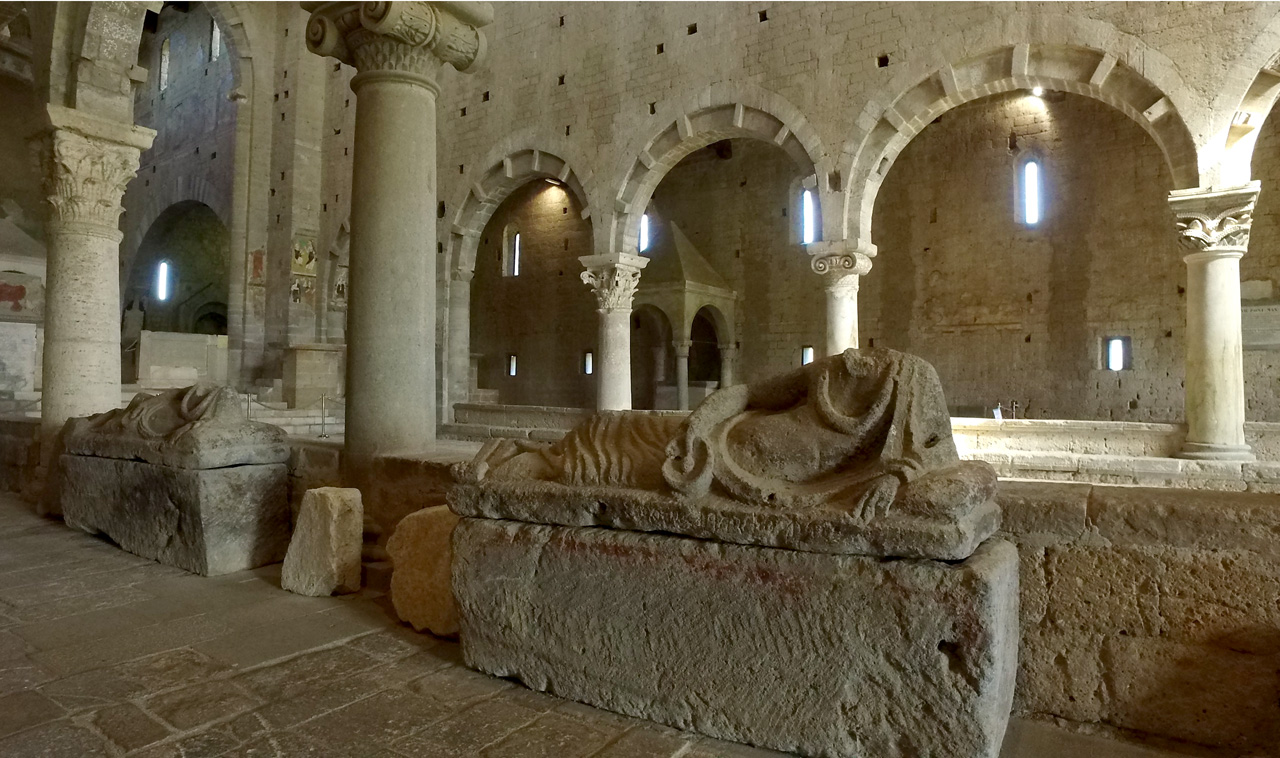
Sacred Splendor: Tuscania's Magnificent Churches
The churches of Tuscania stand as architectural treasures, each bearing a unique historical and cultural significance. Atop the majestic Colle San Pietro, the 11th-century Romanesque Church of Saint Peter reigns supreme, an architectural masterpiece that encapsulates centuries of history. Its intricate facade and awe-inspiring interior reveal the fusion of architectural styles, where Etruscan echoes harmonize with Romanesque grandeur.
Next to the church, you can glimpse the ruins and foundations of ancient Roman villas. From the heights of San Pietro, where panoramic vistas unfurl before you. The rugged crenelated remains of Castello Rivelino paint a storied silhouette against the sky, bearing witness to centuries of Tuscania's resilience. Encircling the town, formidable city walls stand sentinel, cradling within them the remarkable medieval buildings and stately towers that tell tales of Tuscania's enduring architectural and historical legacy.

The Church of Santa Maria Maggiore, located just down the hill from the church of Saint Peter, is a captivating architectural gem that beckons visitors with its enchanting blend of Romanesque and Gothic styles. Its facade, adorned with intricate sculptural details and elegant rose windows, is a testament to the town's rich artistic heritage. Step inside to discover a treasure trove of medieval frescoes and ornate altarpieces that adorn its interior, offering a glimpse into the spiritual and artistic tapestry of Tuscania's past.
The Etruscan Museum of Tuscania
The Etruscan Museum of Tuscania takes visitors on a journey through time. Located in the Franciscan convent founded in 1247, adjacent to the Church of S. Maria del Riposo, the museum features artifacts, sarcophagi, pottery, and bronze sculptures that unveil the daily lives of these enigmatic people. As you explore the museum's treasures, you gain a deeper appreciation for the Etruscans' mastery of craftsmanship and their connection to the land.
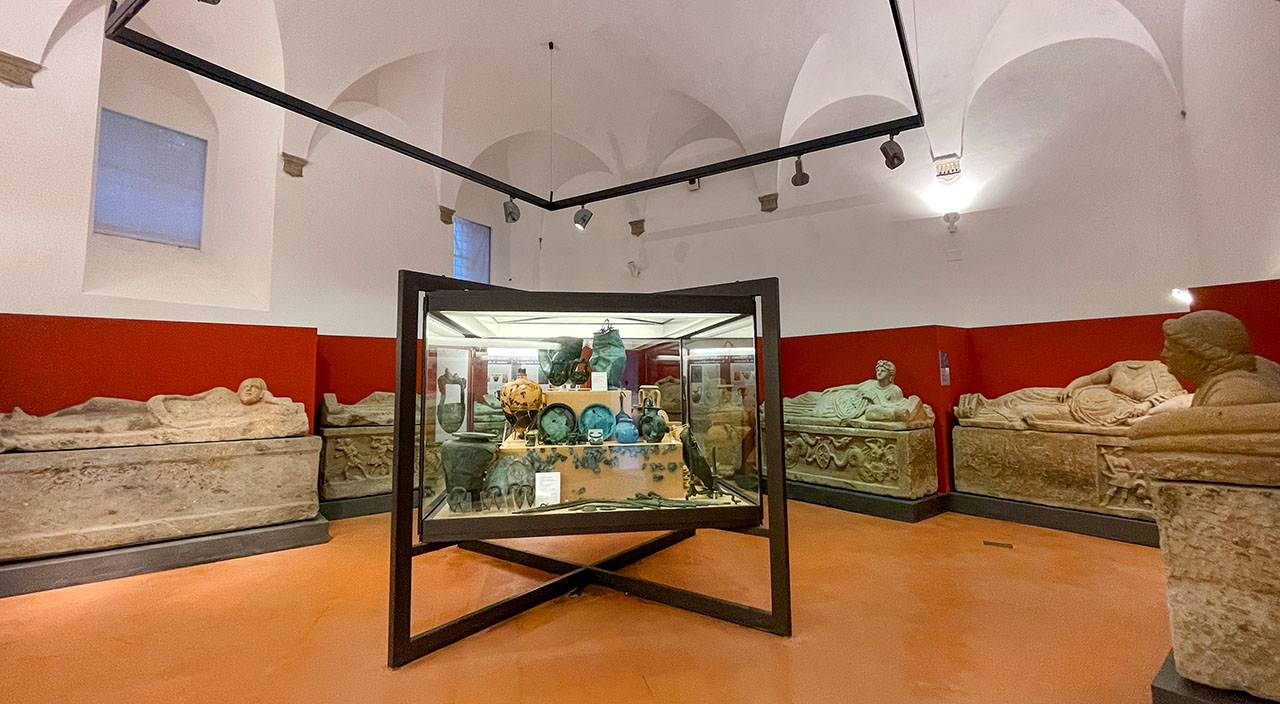
As you leave Tarquinia and Tuscania at the conclusion of our Mysterious Etruscans Countryside Tour, you depart not only with cherished memories of an unforgettable journey but also with a profound appreciation for the Etruscans and the enduring legacies they've bequeathed. Their enduring heritage lingers in the vibrant frescoes, ancient tombs, and whispered stories woven into the fabric of these two towns. Though the Etruscans may have faded into history, their enigmatic allure remains an open invitation for intrepid explorers like yourself to unravel the secrets they've left behind.
So, embark on this journey into a civilization shrouded in mystery on a day trip from Rome or a Shore Excursion from Civitavecchia, and let Tarquinia and Tuscania be your portals to the fascinating world of the Etruscans—a world that continues to captivate, intrigue, and inspire.
Thank you for reading our blog and for choosing Stefano's RomeCabs for your cultural tours in Italy!
* Find us online also on:
- RomeCabs FACEBOOK
- RomeCabs PINTEREST
- RomeCabs TWITTER
- RomeCabs INSTAGRAM
- RomeCabs FLICKR Photo Gallery
- Other RomeCabs travel blog: https://rome-cabs.net/
